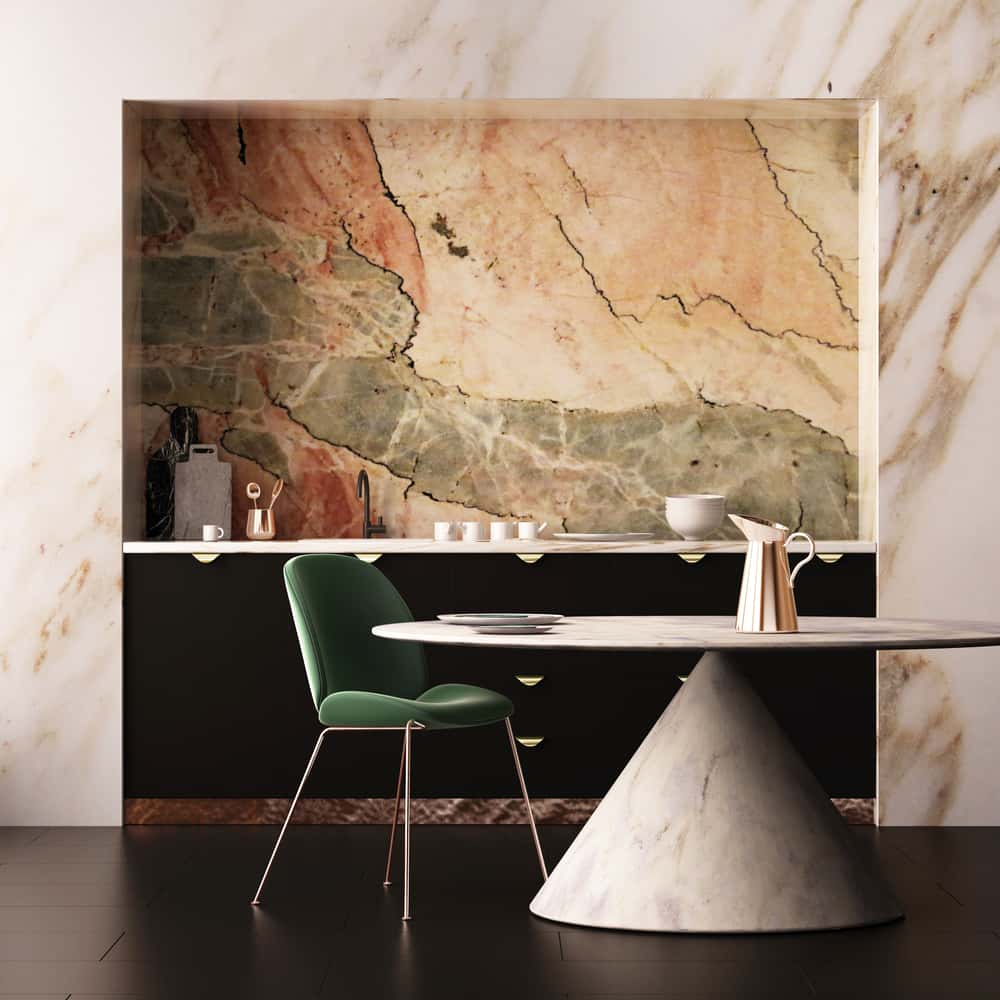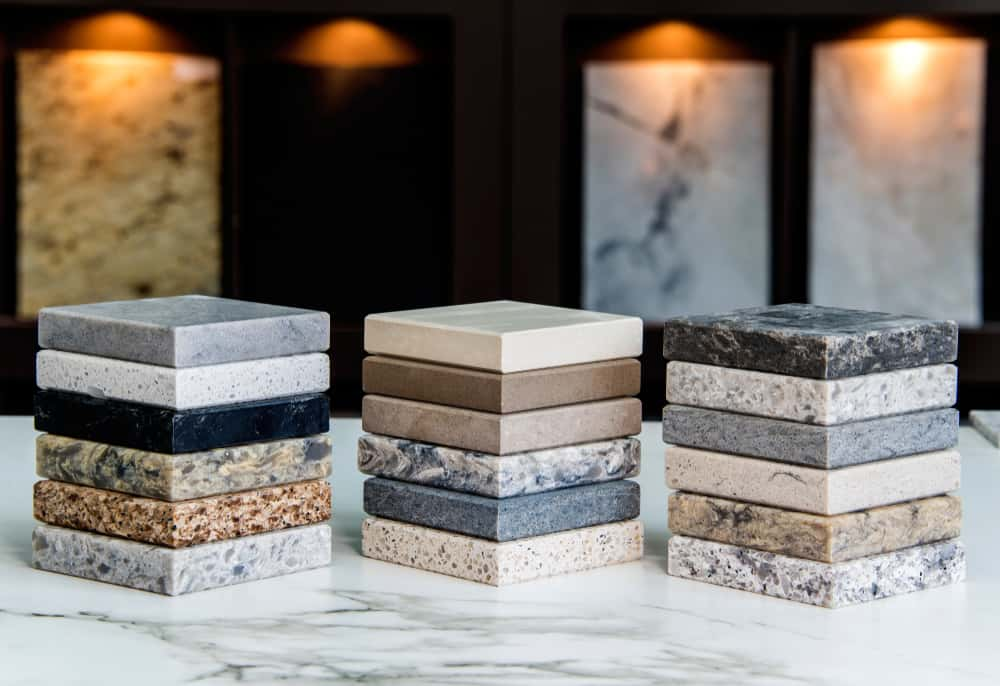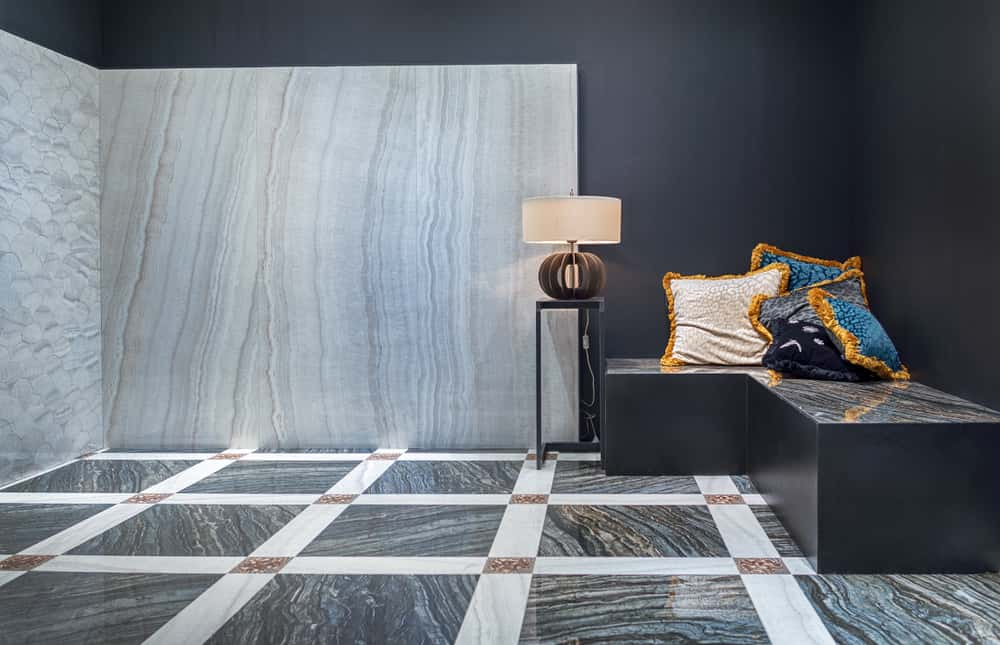Marble and granite are both very popular surfacing materials, and can be used in your home for flooring, wall cladding or countertops. While both natural stones are beautiful, they have very different qualities. How can you choose between them? Here’s a comparative study, so you can make the right decision for your home!

| Marble | Granite | |
| Material Composition | Marble is a natural metamorphic crystalline rock that is made of calcium carbonate, usually limestone or calcite. | Granite is a natural igneous rock that is comprised of mostly quartz and feldspar. |
| Appearance | Generally, marble comes with veins or inflexions in a different colour. These swirls are caused by mineral impurities: for instance, iron oxides result in red or brown veins, while green inflexions are caused by magnesium. The purest marble is white and fine-grained. Every single slab of marble is unique. | The surface of granite contains dark mineral grains in colours that range from red, pink, grey, green, white or black. Many varieties come with lovely flecks, sparkling spangles and veins. Every single slab of granite is unique. |
| Maintenance | Marble requires re-polishing and sealing of the surface every few years in order to retain its characteristic soft, glowing lustre. | Granite, once polished, retains its crystalline shine and does not require re-polishing or sealing. |
| Durability | As marble is a porous stone, it is prone to pitting with even mildly acidic spills such as lime juice or vinegar. Wine spills and oil can also cause it to get stained and discoloured. During cooking, marble countertops can absorb turmeric or food colours and get stained. When used in kitchens, the surface should be polished and sealed well, and any spills should be wiped up at once. | Granite is hard, tough and non-porous, and is much more durable than marble. It is resistant to stains and oil spills, and does not discolour easily. |
| Resistance to Heat | Marble is resistant to heat. | Granite is highly resistant to heat. |
| Resistance to scratching | Marble can get scratched with constant abrasions, such as that of the wheels of an office chair. It can also get scratched with sharp objects. | Granite does not get scratched easily as it is a very hard stone. |
| Cleaning | Marble can be wiped with a damp cloth every day and any organic cleaning liquid when dirty. Avoid chemical cleaners. | Granite can be wiped clean with a damp cloth on a regular basis. Note that granite gets very slippery when wet, so a polished wet floor is hazardous to children and old people. |
| Cost | Depending on the quality, marble costs can range between Rs 350 to even Rs 2000 per square foot (and higher!) | The price of granite ranges from Rs 150 per square foot to around Rs 700 per square foot. |
| Used for | Marble is commonly used in elegant flooring, countertops and tabletops, pooja rooms and wall cladding. Marble is the preferred stone used by artists and sculptors. | Granite is used in flooring, outdoor landscaping, kitchen countertops, tabletops, and as a cladding material. |
| Availability and Colours | White marble is the most popular, but colours can range from yellow, green, through reds and browns. Italian Carrara marble is considered to be the most expensive in the world and comes in shades of white with characteristic fine and feathery bluish-grey veins. | Granite is available in a wide range of colours, ranging from earthy shades to greens, reds and greys. Black granite is the most commonly used variety in countertops. |
Granite or marble? This is a decision that’s not easy to make. Both natural stones lend an air of elegance to your home, which can never be matched by factory-manufactured tiles.
Here’s how to make your choice:

Pro-Tip #1: There are many marble sellers who add pigments, resins and binders to marble of an inferior quality, finish the surface with a mirror-like polish and sell it as ‘Italian marble’. Such slabs are likely to be soft and porous internally, and could easily crack during transport and laying. Always be wary of shops that are selling marble at a price that is much lower than the market rate.
Pro-Tip #2: When calculating the floor area for natural stone floors, always assume that there will be 15 to 20 per cent of wastage and make your purchase accordingly. Since the stone is natural, there are bound to be differences in the grains and colours between different batches. If you run short of material it might be different to get more stone from the same batch, and the appearance of the next batch could be very different.
Pro-Tip #3: When sizing and cutting the stone, calculate slab sizes according to the dimensions of the room. Avoid having cut sizes that will look disproportionate.
Pro-Tip #4. Both marble and granite can be laid with borders and inlays. Decide on the pattern before the stone is cut, to avoid wastage.
Pro-Tip #5: If there is a transition between two types of flooring, such as wood and stone, or stone and ceramic tiles, you should use a transition profile or a threshold strip. Different flooring materials may react to changes in the weather differently, and a transition will not only look neat, but it will help to avoid cracks in the long run.
Pro-Tip #6. Granite for use in outdoor spaces, bathrooms or on steps can be ‘flamed’ to give it a rough appearance and make it non-slippery, even when wet.

So, there you have it—the lowdown on these two popular natural stones! Still not sure which one to choose? Our interior design experts can walk you through the pros and cons and help you pick the finishes and colours that would look good in your home. Do visit one of our HomeLane experience centres, or connect with us online. We’re always happy to help!

 EXPLORE MORE
EXPLORE MORE EXPLORE MORE
EXPLORE MOREBy submitting this form, you agree to the privacy policy and terms of use